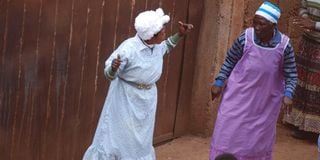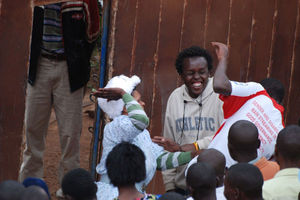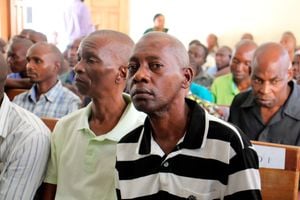
Self-proclaimed prophetess Mary Sinaida Akatsa of Kawangware’s Jerusalem Church of Christ (left) and a member of her church in this picture taken on October 6, 2013.
For decades, Mary Sinaida Akatsa, a self-proclaimed prophetess, courted controversy as big as the crowds of congregants drawn by her miracles. In the late 1980s, politicians and commoners alike thronged to Akatsa’s feet seeking miracles.
With her death on October 26, it is a chapter closed for a woman who inspired fervent devotion and equally intense criticism.
Known endearingly to her followers as “Dada Mary”, her church services — held at a sanctuary she established in Nairobi’s Kawangware 56 area — were never ordinary gatherings. Instead, they transformed into spaces of both divine inspiration and strong discipline, where latecomers often faced immediate retribution in the form of a slap or a public scolding.
When a Nation team attended a worship session in 2013, it witnessed a session where she held three young men by their shirts and slapped them to “exorcise the demons of death”. At the same session, she took offence with a woman whose dress was not long enough and asked her to go and never come back because she would not allow “prostitution in church”.
On some occasions, Akatsa would ask men to carry their wives on their backs as punishment for marital transgressions and once brought in a mysterious man and convinced her followers that he was Jesus.
Her actions often drew intense scrutiny, yet she remained a fixture in Kenya’s religious landscape.
Following her death while receiving kidney treatment at a local hospital, some of her faithful followers say Akatsa was not merely a pastor but a genuine vessel of miracles—a woman uniquely gifted in spiritual matters, whose prayers were believed to manifest miracles in those who approached her with unwavering faith.
On the other hand, some viewed her with suspicion, saying she was simply a charismatic yet controversial figure who tapped into people’s vulnerabilities for her own gain.
Susan Iminza worked with Akatsa in Kikuyu, Kiambu County, when they were both domestic workers. She recalls meeting the “prophetess” in the 1970s.
Before assuming the mantle of a prophetess with a unique ministry, she says Akatsa had a rather humble beginning as a housemaid. Susan recalls that even in her early days, Akatsa had a remarkable “gift for prayer.” She remembers how Akatsa would fervently pray, often focusing on the needs of her employers and others around her.
“She was just an ordinary person who believed deeply in prayer,” Susan says. “Mary would pray about any problem you shared with her, and eventually, her dedication to prayer drew people to her. Soon, she began to gather followers, and her journey as a spiritual leader took off, eventually leading her to start her own church in Kawangware.”
The two reconnected later after Susan moved from Kikuyu. During that time, Susan was facing marriage challenges.
“By that time, Dada Mary was also married. I was going through problems in my marriage that made her visit me frequently,” she says. “She prayed for me, and God answered my prayers through her.”
The blind, lame and barren
By the late 1980s, Akatsa’s ministry was beginning to gain traction. Stories of miraculous healings and answered prayers spread quickly, drawing more people into her fold. Her influence grew so much that local media began reporting on her work. In April 1988, Taifa Leo drew public attention with stories of Akatsa’s prayers for the blind, the lame, and the barren.
Margret Nasa Wambua, one of Akatsa’s previous followers, believed that the preacher’s prayers were instrumental in fertility. She says Akatsa prayed for her and she got five more children.
Margaret tells Lifestyle that she had waited for seven years without conceiving, yet she was not barren. She had had two children but her mother-in-law wanted her to have more. She says Akatsa the “prophetess” told her that her womb was interfered with by a midwife during the birth of her second child.

'Prophetess' Mary Sinaida Akatsa slaps members of her church for disciplinary issues on October 6, 2013. This was done before they could enter the church compound.
“One day, she looked at me and said I didn’t have secondary infertility. She said the reason I was not pregnant was because the midwife who helped me to deliver my second child blocked my womb and uterus with [dark] forces,” says Margaret.
“During that time, my mother-in-law was pestering me to get pregnant, which made me close to the ‘prophetess’. After several months of her prayers, I conceived.”
Now a mother of seven, Margaret says Akatsa gave her guidelines to ensure safe delivery of the children. She was instructed to wear long dresses whenever she stepped out of her house.
“Dada Mary instructed me to wear long clothing so that the midwife who had bound me wouldn’t know I was pregnant. It really worked for me and I ended up giving birth to five more children, one year after another,” says Margaret.
This profound experience left such an impression on her that she continued to wear long, flowing dresses—a practice Akatsa had recommended to shield her from malevolent forces that she claimed could harm her pregnancy. The dress code has been adopted by her followers, who believe that it protects them against witchcraft.
Margaret says Akatsa was not only praying for the barren. The sick were healed too through her fervent prayers.
After giving birth to her third child, her baby became sick. Margaret says she moved from one hospital to another seeking treatment for her child. Later, she decided to seek Akasta’s services. The preacher ordered her to run around a large field as she “rebuked” the unknown disease.
“That field over there, [she points at a field] I ran around it many times. We believe when you run, you leave your problems behind. I ran 23 laps as I shouted, ‘Jesus, heal my child.’ And she got healed,” says Margaret.
Margaret named one of her children Sinaida, after Akatsa; and another Francis, after Akasta’s husband.
Akatsa’s ministry, however, was not only renowned for the miracles her followers spoke of; it was equally famous for the controversial and bold acts she undertook. In a dramatic episode in 1988, she astonished her congregation by introducing a man whom she presented as “Jesus,” leading him into her Kawangware church.
This mysterious figure, a bushy-haired Asian man clad in white, wandered barefoot among her congregants, and for some worshippers, his striking appearance was enough to spark feelings of awe and reverence. Some worshipped the man and even told him their troubles, though there were doubters among the congregants.
“We shouted and addressed him as Jesus of Nazareth, asking him to forgive our sins,” recalls Francis Kirato, a former follower of Akatsa. “On Sunday, he was picked up by another person, an Asian man, and they left. We believed he was returning to heaven. As he departed, we raised our hands to bid him farewell...to heaven.”
According to Francis, the “Jesus” left them in shock especially when he spoke to them in Kiswahili during gatherings that were held for three days.
The incident ignited both reverence and ridicule, sparking a fierce public debate, with some condemning her for misleading the congregation and others defending her actions as an example of her profound faith. A letter that the Nation published on July 16, 1988, captured some readers’ uneasiness.
“I strongly disagree with the ‘prophetess’ Mary Akatsa’s claim of Jesus visiting her prayer meeting at Kawangware. I find it difficult to believe her testimony,” wrote SM Mac-Donald from Wajir. “From my point of view, after studying the photograph, I concluded that this man looks more or less like a Singh. How come he was driven by an Indian?”
Death in Kibera
The same month of July 1988, Akatsa’s name was in the headlines again when one Gabriel Ouma Ngira tragically died during a stampede outside the Kibera Law Courts after she lost a court case. The incident, reported by Nation, prompted widespread discussion about the role of religious leaders and the potential dangers of congregations that rallied passionately behind charismatic figures.
“Mr Ngira was crushed to death when followers of self-proclaimed ‘prophetess’ Mary Sinaida Akatsa went on the rampage on hearing that she had lost the case against a Nairobi lawyer, Mr Timothy Okwaro. Akatsa had sued Mr Timothy Okwaro, claiming he had created a disturbance likely to cause a breach of the peace by interrupting prayer meetings conducted by her on January 24 and 30,” the Nation reported in its July 9, 1988 edition.
This inspired an editorial in the Daily Nation of July 10, 1988 which was titled “Worshipping Within Acceptable Bounds”.
“The stampede outside the Kibera law courts on Thursday, which left one person dead, shows how easy it is to misuse the name of religion and endanger public safety. And it makes it necessary to point out that the freedom of worship, which is enshrined in our Constitution and respected by a majority of Kenyans, should not be an open cheque for those who neither respect the rights of other people nor the laws of the land,” started the 620-word write-up.
“Thursday’s stampede and the resulting toll should not have arisen in the first place if everyone had respected the law and the rights of others. When ‘Prophetess’ Mary Akatsa complained to the police about the defendant in the case, she was within her rights as a Kenyan who felt aggrieved.

But once she did so, she had to accept the primacy of the court to decide, on the evidence brought before it, whether there was a case against the accused or not. And if it ruled against the prosecution and the complainant, she could do nothing but accept the verdict. Even if she felt dissatisfied with the ruling, she had other possible legal avenues. To try to short-cut that process is tantamount to breaking the law and risking prosecution,” it added.
Further research in the Nation archives shows that in earlier 1988, a man had been fined Sh2,000 by a Kibera court for abusing Akatsa.
“The charge said that on January 27 this year, in Kawangware, he attacked Akatsa and abused her, pushing her as she prayed for thousands of people who had gone to her with their problems,” says a paragraph we translated from the Taifa Leo edition of April 22, 1988.
Expansion
As Akatsa’s ministry continued to expand, she moved her congregation to an open-air site in Kawangware 56, where she eventually bought land to establish a more permanent place of worship. This move, however, came with a cost, as some members of her congregation began to feel uncomfortable with what they saw as a shift in her approach.
When Lifestyle visited the premises last week, the land had spacious grounds with only three structures. The biggest structure therein is an unfinished church that has only iron roofing sheets supported by timber. In front of that structure are two small corrugated iron-sheet houses.
Margaret tells Lifestyle that some followers moved out of the church when Akatsa purchased the land in 1993. She began selling blessed items at the altar, an act that many long-time followers viewed as a departure from her earlier principles. Margaret, who has since joined a different church, recalls feeling disillusioned when Akatsa began this practice.
“I was shocked to see the ‘prophetess’ selling clothes and other items she said were blessed. That’s when I realised the spirit had left her,” says Margaret.
Akasta was also accused of selfishly running the church without allowing other leaders to establish branches elsewhere.
“Many preachers urged her to let them open branches, but she refused. Followers seeking her services from outside Nairobi had to travel to see her,” said another follower.
Men and discipline
Akatsa’s legendary strictness in enforcing discipline among her congregation also became well-known. Errant husbands who failed to care for their families or neglected their marital responsibilities often found themselves on the receiving end of her unusual punishments.
Zacharia Oluoch, a father of five, recounts being forced to kneel and publicly apologise to his wife after she reported him for neglect. In one memorable instance, Akatsa, who was among the few female preachers then, ordered him to place his wife’s skirt on his head and run laps around the church as an act of penance, ensuring he would remember his vows and responsibilities.
“I regretted going to seek peace for my marriage. After kneeling and asking for forgiveness, I was told to wear my wife’s skirt on my head and run around as a form of apology for straying,” Zacharia says.
According to Zacharia, the “prophetess” gave him a tough punishment of kneeling before his wife and also wearing his wife’s underwear on the head.
“I wondered what kind of punishment that was, but I had no option but to do it. That was a symbol showing the world I was married to one wife,” he says.
At other times, men who had conflicts with their wives were forced to carry their spouses on their backs and go around the field.
Her strict discipline extended beyond her congregation to her promises of healing for even the gravest ailments, including claims that she could cure illnesses like Aids.
For those like Zainabu Hassan, who is named Sinaida in honour of Akatsa, the prophetess’s name carries a lasting sense of pride.
“My mother, who was very close to her, named me after her, and to this day, I’m proud to carry her name. I will be there for her burial,” says the 33-year-old.
She is one of 15 young people named Sinaida planning to attend Akatsa’s burial.
“I am Muslim, and I was given that name at birth because my mother was her close friend. On the day of the final ceremony, a vehicle with those named after her and her husband will be part of her funeral entourage,” says Zainabu.
Akatsa was born in Bunyore, Vihiga County, to a humble family. She later pursued an unconventional path to ministry.
Her burial was initially scheduled to take place in Kakamega but on Friday, Jerusalem Christ Church Chairman Ezekiel Asava said the “prophetess” would be buried in Nairobi, as per her last wishes.
“We need Sh6 million to complete the journey of the prophet. Her body will be buried here [in Kawangware] after the final committee holds a meeting on Monday. She left a wish that she should be buried here,” said Asava.
Akasta has two sons who live in Karen, Nairobi.







